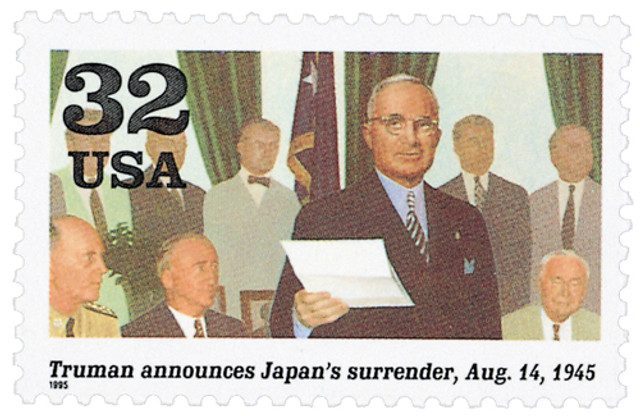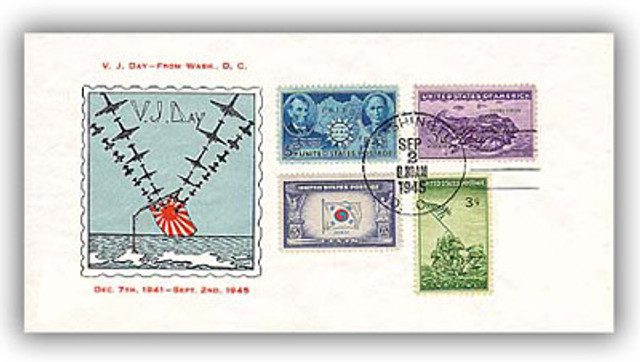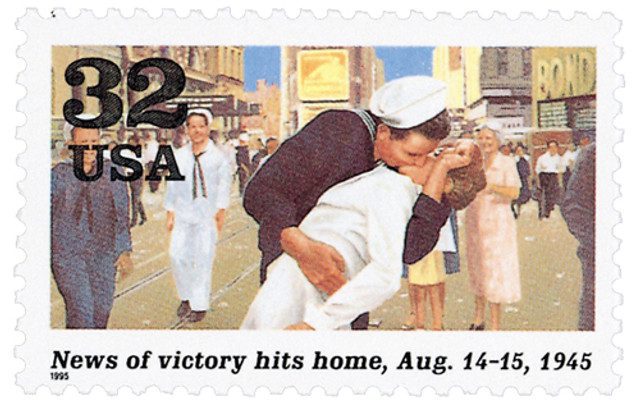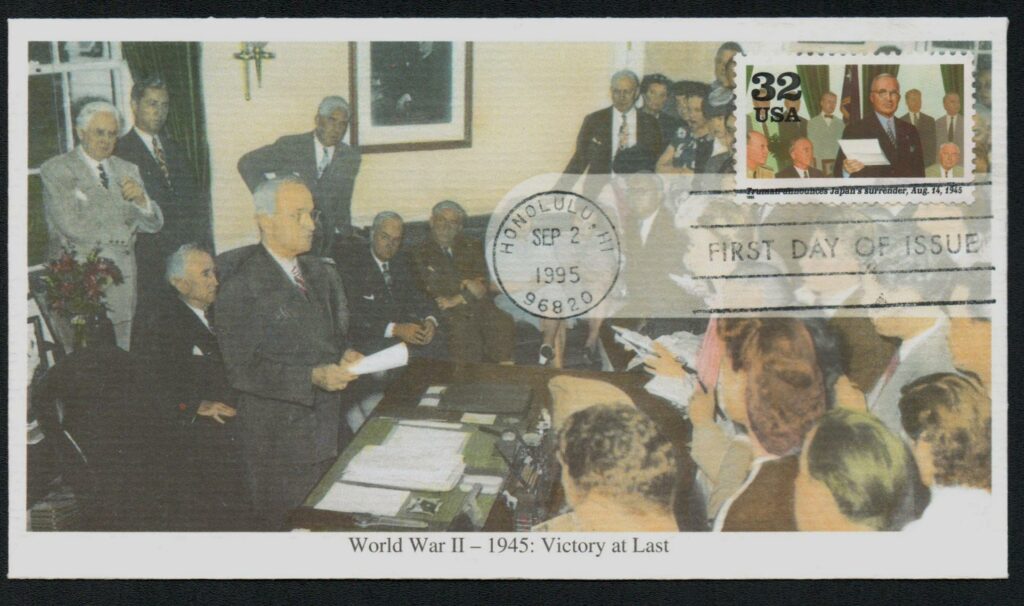After nearly six years of a world at war, the Japanese surrendered on August 14, 1945, effectively ending World War II.
By the summer of 1945, Germany had surrendered, ending the war in Europe. However, Japan refused to surrender and continued to fight. The Allies felt they had little choice but to launch a major attack. Experts estimated one million U.S. casualties would be incurred in this invasion. Japanese losses would have been much higher.
However, the U.S. had been secretly working on an atomic bomb, dubbed the “Manhattan Project,” which was ready to be deployed that August. The Allies gave Japan one last chance – surrender unconditionally, or be destroyed. When they refused, the U.S. dropped its first atomic bomb on Hiroshima on August 6. Despite the loss of nearly 100,000 lives, Japan still wouldn’t surrender. Three days later, the U.S. dropped a second bomb on Nagasaki, claiming another 40,000 lives. (Historians from both countries agree that the atomic bombs actually saved American and Japanese lives.)
On August 10, in the wake of the extreme losses and concerns over another bomb, the Japanese government said it would surrender under the terms of the Potsdam Declaration. However, the number of changes they wanted made to it was unacceptable to the Allies.
Though the Japanese hadn’t yet formally surrendered, this news was enough to begin celebrations around the globe. In London Allied troops danced in conga lines through the streets, while soldiers in Paris paraded on the Champs-Elysées singing “Don’t Fence Me In.” The people of Manila sang “God Bless America,” while U.S. troops in Okinawa fired every available weapon into the sky in celebration.
A little after noon on August 15, local time in Japan, Emperor Hirohito announced that he would accept the terms of the Potsdam Declaration. In America (where it was still August 14), President Harry Truman delivered the announcement at 7:00 that evening, though the formal surrender ceremony wouldn’t be held until September 2.
The moment the news hit, Americans began celebrating “as if joy had been rationed and saved up for the three years, eight months and seven days since Sunday, Dec. 7, 1941,” as Life magazine put it. Huge crowds took to the streets across the country.
In Washington, D.C., a large crowd tried to get into the White House grounds shouting, “We want Harry!” Eventually, the president stepped outside and announced, “This is the day we have been waiting for since Pearl Harbor. This is the day when Fascism finally dies, as we always knew it would.” New York’s Times Square had its largest gathering up to that time – about 2 million people. In the city’s garment district, workers threw cloth scraps and ticker tape in celebration. Celebrations continued around the world for the next two days with fireworks and parades.
Click here to see photos of V-J Day celebrations.
Click here to read last year’s discussion about This Day in History.






When one realizes they were alive during that time frame it become extremely personal and has a tendency to cause the sinuses and the tear ducts to be affected. The whole piece of history and its final result is worthy of giving all praise to the LORD.
Amen Brother!!!
Please, if you want to praise anyone, praise the soldiers, airmen and sailors.
Many still think that dropping the Bombs was immoral. When told almost every
military experts in the world said it saved many times more lives than were lost to
the two bombs. The Allied casualties would have been horrific. The U.S. alone
would have lost over 200,000 lives-half again how many were lost from 1941 to
Aug 1945. Over one million Allied injured. Japanese losses were estimated at 2.5
million + dead and million more injured because the Japanese leadership would
considered every citizen a soldier to fight to the death.
The absolute worst condemnation of the dropping of the bombs was a Professor
who said “That so many Americans would have been killed is no reason to kill so
many Japanese because their lives were worth as much as the Allies lives”. A real
fantasy world statement. Also, it was U.S. racism because we dropped the bombs on
Japan and not Germany. They never think that Germany surrendered on May 6th.
exactly 3 months before we dropped them on japan and 71 days before the first test
of the Atom Bomb. You can’t use something that hasn’t even finished its development.
EVERY WW11 veteran with whom I discussed the atomic bomb drop on Japan said the same thing, they were glad it happened to force the surrender. No one looked forward to an invasion of the home islands against a suicidal enemy. Anyone who wrings their hands about it in a safe and and removed distance in time never faced the Japanese military, from Nanking, China, Pearl Harbor, through the Pacific War. As said elsewhere, the Nazis would have hit by the atomic bomb, but the war in Europe ended before the first test
I was 10 years old and remember the joy expressed by relatives that the war was over and that three uncles would not be faced with being involved in the invasion of Japan. No one even considered whether or not dropping the bombs was immoral. They were just so happy that their loved ones would be coming home soon.
I was just a young boy when that news came out. Everyone was excited and overjoyed. It was not until I read the book “Fly Boys” about George Bush seniors entire squadron big shot down on a mission that I understood the mentality of the Japanese and their military. Bush’s plane crashed far enough at sea that his raft was not draw to that Japanese held island. most crews were able to bail out but what they endured before they were killed was beyond human belief. This is about stamps and history so let us remember the history of heroic men who died for the cause of freedom. The sacrifice on Iwo Jima and Okinawa were a hit of what was waiting for us in an invasion of the Japanese mainland. The Japanese are not that same people today but there are other hostile groups with the same mentality.
More people were killed in the “conventional” fire-bombing of Toyko in 1945 than in the nuclear bombing of Hiroshima or of Nagasaki. Are the dead from conventional weapons any less dead than those from nuclear weapons?
In the same vein, the Japanese killed some 250,00 Chinese in the capture of the Chinese capital, Nanking. The 250,000 Chinese are all dead. The Japanese killed the 250,000 Chinese in the old-fashioned way: bullets, bayonets, and clubbing. Just as spectacular as nuclear bombing, two Japanese officers competed to see how many Chinese they could behead. Then, of course, is the refined Japanese method of burying Chinese alive.
Whose killings are more moral?
When I see these pictures at VJ Day, I feel bad because I was in an army hospital in California.
I was in pin traction on the right leg and in hip spike cast on the left leg. I could move so I lost the
time of out kissing all the girls. I could not even catch a nurse to kiss. but we won a war and we were feee again to develop this great nation. My prays are that my grand and great kids do not have to face a war.
Immersing oneself in the WWII era is certainly an intriguing experience with the Allies representing democracy and the Axis representing fascism one must truly commend the daunting courage and determination the people of this great nation put forth in order to defend democracy. It is a true blessing that a declaration could be inferred in order to establish peaceful terms. God Bless America and the republic for which it stands!
I was at Okinawa when the announcement of wars end came over our ships speakers. I immediately went topside and saw the greatest fireworks display I ever saw before or since. Of course, everyone was fireing live ammunition, so I immediately went back below deck and the next morning was told 12 men we killed by that fireworks display!!
I remember reading that invasion of Japan as scheduled for November of 1945.
In case anyone’s counting, sixty million lives were lost because of Nazi and japanese aggression. Do the math. No sane person is shedding any tears for anyone capable of such horror. Let’s all hope it never happens again because if we hadn’t dropped the bombs, it probably would have happened eventually. They showed the world that we must never do that again. So far it’s worked.